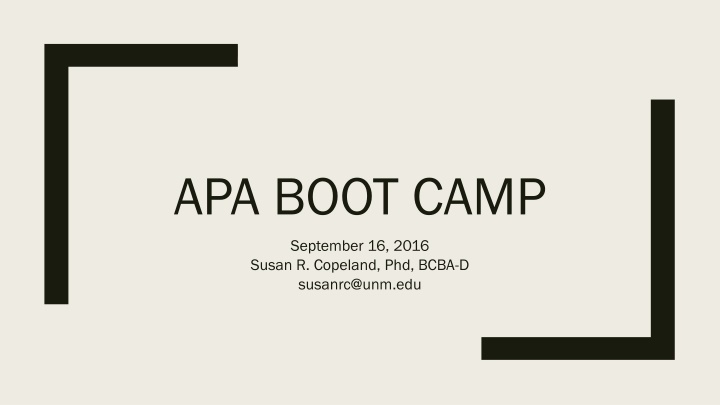
Effective Usage of Headings and Tables in APA Formatting
Learn how to effectively utilize headings and tables in APA formatting to enhance the organization and presentation of your academic papers. Understand the proper structure, formatting guidelines, and best practices for incorporating headings and tables in accordance with the APA Manual of Style. Improve the clarity and readability of your documents through this comprehensive guide.
Download Presentation

Please find below an Image/Link to download the presentation.
The content on the website is provided AS IS for your information and personal use only. It may not be sold, licensed, or shared on other websites without obtaining consent from the author. If you encounter any issues during the download, it is possible that the publisher has removed the file from their server.
You are allowed to download the files provided on this website for personal or commercial use, subject to the condition that they are used lawfully. All files are the property of their respective owners.
The content on the website is provided AS IS for your information and personal use only. It may not be sold, licensed, or shared on other websites without obtaining consent from the author.
E N D
Presentation Transcript
APA BOOT CAMP September 16, 2016 Susan R. Copeland, Phd, BCBA-D susanrc@unm.edu
Headers and Headings & Other Organizational Tools Formatting headers, headings, page numbers; using headings to help organize a paper Chapter 3 in the APA Manual of Style (6thed.)
Headings (APA Manual of Style, sections 3.02 3.02, 3.03) , 3.03) Headings help organize your paper. Tip: outline your paper before writing and make the points in your outline the headings Each section of the paper begins with the highest level of heading EXCEPT the Introduction. Do not use a heading for the Introduction that labels it as Introduction (p. 63)
Resources on headings in the APA Manual Table 3.1 (p. 63) showing levels of headings If only one level of heading is needed use Level 1; for a paper with two levels of heading, use Levels 1 and 2; if three levels are needed, use Levels 1, 2, and 3; and so forth. (p. 63) Figure 2.1 (sample paper, pp. 41-59) showing how headings look (font and spacing) within a paper. Tip: Don t rely on a published article because journals and books use different fonts and formats.
Test your skills! Work with someone sitting next to you to to find and correct correct the APA errors on the three sample manuscript pages. find and
Tables Constructing and formatting tables Chapter 5 in the APA Manual of Style (6thed.)
Tables (Chapter 5 Displaying Results) Tables convey important information for your paper. When considering whether or not to use a table or what type of table to use, ask yourself first what is the purpose of your table, look at published examples of tables with that same purpose to see how others have conveyed that type of information, talk with your course instructor or advisor about whether or not to use a table and/or how to use one effectively.
Parts of a Table Look at Table 5.1 in the APA Manual of Style (6th Ed.)
Tables Table 1 Demographic Information Number tables in the order in which you will refer to them in your paper (Section 5.05). Give tables a title that briefly conveys what the information in the table is about. Italicize the title (5.12). Table 2 Description of Themes Single or double space tables but always consider readability (5.17).
Tables Refer to tables in the body of your paper as Table 1, Table 2, Table 3, etc. In this section we describe both the formats researchers used to elicit perceptions of satisfaction (e.g., types of questions used in interviews) and the process or manner in which researchers conducted interviews (see Table 1). Do NOT put in things like Insert Table 1 here . ALWAYS get someone to read over your table (and your paper) to check for typos, formatting issues, etc. If that is not possible, complete your paper a few days ahead of a deadline, put it down, and then go back to it after a few days to edit. You will be amazed at how many more errors you can find after putting it aside for a few days.
Tables Use general, specific, and/or probability notes to help readers understand the information in your table (Section 5.16). These go below the table.
Placement of Tables 1. Title page 2. Abstract 3. Body of the paper 4. References 5. 5. Tables Tables 6. Figures 7. Appendices Place tables after the Reference section within your paper. (See Section 8.03, pp. 229- 230, for the order of manuscript pages.) Each table gets its own page(s).
How to insert a table into a Word document Home Home Open Word document Open Word document Insert Insert Table Table create size you want (if you want a landscape table go back to format document and select landscape) Put in the content you want Borders Borders select the rules (lines) to match APA guidelines Borders & Shading click lines (rules) off/on until you have what is needed for this table.
You try it Open the template Dr. Griffin gave you at the last Boot Camp (or a Word document) Use the task analysis on the previous slide; your version of Word may be older or newer than mine, but the order is still the same.
You try it! Work with someone sitting next to you to find and correct the APA formatting errors on the sample table. How many can you find???
Other Resources Presenting Your Findings: A Practical Guide for Creating Tables, 6thEd. (American Psychological Association; ISBN: 978-1-4338-0705-3) http://www.apastyle.org/products/4316117.aspx?tab=1 Table Tips (APA Style Blog) http://blog.apastyle.org/apastyle/2009/11/table- tips.html?_ga=1.96169307.698588307.1471111007
